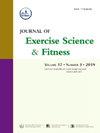不同运动类型降低老年糖尿病周围神经病变患者跌倒风险的有效性:一项系统综述和荟萃分析
IF 2.4
2区 医学
Q2 SPORT SCIENCES
引用次数: 0
摘要
糖尿病周围神经病变(DPN)增加糖尿病患者跌倒的风险。由于用于评估跌倒风险的变量不同,运动对预防跌倒的影响仍然不一致。本研究回顾并比较了不同运动对老年DPN患者跌倒风险的影响。方法对截至2025年2月17日的PubMed、EBSCO、Web of Science、Cochrane Library进行综合文献检索。纳入标准为:患有DPN的老年人;仅进行运动干预的对照组,不运动或不运动的对照组,以及随机对照试验,结果变量:起跑计时(TUG)时间,步态速度,伯格平衡量表(BBS)评分,单腿站立(OLS)时间,睁眼(EO)和闭眼(EC)。计算平均差(MD)和95%置信区间(CI)。结果共21篇文章,包括5种运动类型:平衡运动(BE)、多组分运动(ME)、力量运动(SE)、全身振动运动(WBV)和足踝功能训练(FT)。BE缩短了TUG时间(MD = - 1.47, 95% CI = - 1.79 ~ - 1.15),增加了步态速度(0.11,0.04-0.18)、BBS评分(0.93,0.49-1.37)和OLS时间(EO: 2.72, 1.86-3.58;电子商务:1.58,1.0 - -2.17)。ME减少了TUG时间(- 1.71,- 2.26至- 1.17),增加了BBS评分(2.0,1.28-2.72)和OLS时间(EO: 7.07, 4.35-9.79;Ec: 2.61, 1.28-3.94);SE减少了TUG时间(- 1.45,- 2.75至- 0.15),增加了步态速度(0.09,0.06-0.12);WBV增加OLS时间(EO: 1.94, 1.32-2.56;EC: 1.86, 0.16-3.56),但不影响TUG时间或步态速度。FT不影响TUG时间或步态速度。结论:运动可降低老年DPN患者的跌倒风险。BE和ME能有效降低跌倒风险,其次是SE。WBV改善了静平衡,但不利于动平衡。FT对预防跌倒的效果有限,不推荐使用。本文章由计算机程序翻译,如有差异,请以英文原文为准。
Effectiveness of various exercise types in reducing fall risk among older adults with diabetic peripheral neuropathy: A systematic review and meta-analysis
Background
Diabetic peripheral neuropathy (DPN) increases fall risk in diabetics. Due to varying variables used to assess fall risk, the impact of exercise on fall prevention remains inconsistent. This study reviews and compares the effects of different exercises on fall risk among older adults with DPN.
Methods
A comprehensive literature search was conducted in PubMed, EBSCO, Web of Science, and Cochrane Library up to February 17th, 2025. Inclusion criteria were: older adults with DPN; exercise intervention only, an inactive or non-exercising control group, and randomized controlled trials with outcome variables: timed up and go (TUG) time, gait speed, Berg Balance Scale (BBS) score, one-legged standing (OLS) time with eye open (EO) and closed (EC). The mean difference (MD) and 95 % confidence interval (CI) were calculated.
Results
A total of 21 articles included five exercise types: balance exercise (BE), multi-component exercise (ME), strength exercise (SE), whole-body vibration (WBV) and foot-ankle functional training (FT). BE reduced TUG time (MD = −1.47, 95 % CI = −1.79 to −1.15) and increased gait speed (0.11, 0.04–0.18), BBS score (0.93, 0.49–1.37), and OLS time (EO: 2.72, 1.86–3.58; EC:1.58, 1.0–2.17). ME reduced TUG time (−1.71, −2.26 to −1.17) and increased BBS score (2.0, 1.28–2.72) and OLS time (EO: 7.07, 4.35–9.79; EC: 2.61, 1.28–3.94); SE reduced TUG time (−1.45, −2.75 to −0.15) and increased gait speed (0.09, 0.06–0.12); WBV increased OLS time (EO: 1.94, 1.32–2.56; EC: 1.86, 0.16–3.56) but did not affect TUG time or gait speed. FT did not affect TUG time or gait speed.
Conclusions
Exercise reduced fall risks among older adults with DPN. BE and ME were effective in reducing fall risks, followed by SE. WBV improved static balance but failed in dynamic balance. FT showed limited effects on fall prevention and was not recommended.
求助全文
通过发布文献求助,成功后即可免费获取论文全文。
去求助
来源期刊
CiteScore
5.10
自引率
3.60%
发文量
54
审稿时长
31 days
期刊介绍:
The Journal of Exercise Science and Fitness is the official peer-reviewed journal of The Society of Chinese Scholars on Exercise Physiology and Fitness (SCSEPF), the Physical Fitness Association of Hong Kong, China (HKPFA), and the Hong Kong Association of Sports Medicine and Sports Science (HKASMSS). It is published twice a year, in June and December, by Elsevier.
The Journal accepts original investigations, comprehensive reviews, case studies and short communications on current topics in exercise science, physical fitness and physical education.

 求助内容:
求助内容: 应助结果提醒方式:
应助结果提醒方式:


